Nokia G240WG Operators Guide

Release 05.08.01a | August 2018 | Edition 01
7368 Intelligent Services Access
Manager ONT
7368 ISAM ONT G-240W-G Product Guide
3FE-47555-AAAA-TCZZA
Issue: 01
Nokia — Proprietary and confidential
Use pursuant to applicable agreements

Release 05.08.01a | August 2018 | Edition 01
7368 ISAM ONT G-240W-G Product Guide
Nokia is a registered trademark of Nokia Corporation. Other products and company names mentioned herein may be trademarks or tradenames of their respective owners.
The information presented is subject to change without notice. No responsibility is assumed for inaccuracies contained herein.
© 2018 Nokia.
Contains proprietary/trade secret information which is the property of Nokia and must not be made available to, or copied or used by anyone outside Nokia without its written authorization. Not to be used or disclosed except in accordance with applicable agreements.
2 |
3FE-47555-AAAA-TCZZA |
Issue: 01 |

Release 05.08.01a | August 2018 | Edition 01
7368 ISAM ONT G-240W-G Product Guide |
Preface |
1 Preface
This preface provides general information about the documentation set for optical network terminals (ONTs).
1.1Scope
This documentation set provides information about safety, features and functionality, ordering, hardware installation and maintenance, and software installation procedures for the current release.
1.2Audience
This documentation set is intended for planners, administrators, operators, and maintenance personnel involved in installing, upgrading, or maintaining the ONTs.
1.3Required knowledge
The reader must be familiar with general telecommunications principles.
1.4Acronyms and initialisms
The expansions and optional descriptions of most acronyms and initialisms appear in the glossary.
1.5Assistance and ordering phone numbers
Nokia provides global technical support through regional call centers. Phone numbers for the regional call centers are available at the following URL: http://support.alcatel-lucent.com.
For ordering information, contact your Nokia sales representative.
Issue: 01 |
3FE-47555-AAAA-TCZZA |
3 |

Release 05.08.01a | August 2018 | Edition 01
Preface |
7368 ISAM ONT G-240W-G Product Guide |
1.6Nokia quality processes
Nokia’s ONT quality practices are in compliance with TL 9000 requirements. These requirements are documented in the Fixed Networks Quality Manual 3FQ-30146-6000-QRZZA. The quality practices adequately ensure that technical requirements and customer end-point requirements are met. The customer or its representatives may be allowed to perform on-site quality surveillance audits, as agreed upon during contract negotiations
1.7Safety information
For safety information, see the appropriate safety guidelines chapter.
1.8Documents
Documents are available using ALED or OLCS.
Procedure 1 To download a ZIP file package of the customer documentation
1Navigate to http://support.alcatel-lucent.com and enter your user name and password. If you are a new user and require access to this service, please contact your Nokia sales representative.
2From the Technical Content for drop-down menu, choose the product.
3Click on Downloads: Electronic Delivery.
4Choose Documentation from the drop-down menu and click Next.
5Select the image from the drop-down menu and click Next.
6Follow the on-screen directions to download the file.
4 |
3FE-47555-AAAA-TCZZA |
Issue: 01 |
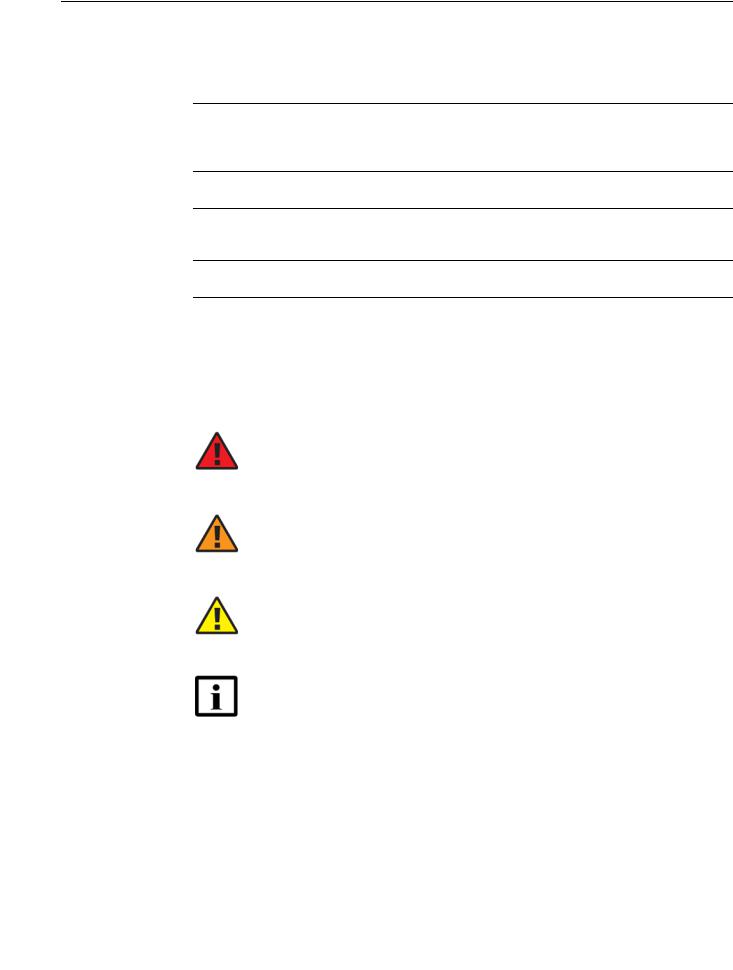
Release 05.08.01a | August 2018 | Edition 01
7368 ISAM ONT G-240W-G Product Guide |
Preface |
Procedure 2 To access individual documents
Individual PDFs of customer documents are also accessible through the Nokia Customer Support website.
1Navigate to http://support.alcatel-lucent.com and enter your user name and password. If you are a new user and require access to this service, please contact your Nokia sales representative.
2From the Technical Content for drop-down menu, choose the product.
3Click on Manuals and Guides to display a list of customer documents by title and part number. You can filter this list using the Release drop-down menu.
4Click on the PDF to open or save the file.
1.9Special information
The following are examples of how special information is presented in this document.
Danger — Danger indicates that the described activity or situation may result in serious personal injury or death; for example, high voltage or electric shock hazards.
Warning — Warning indicates that the described activity or situation may, or will, cause equipment damage or serious performance problems.
Caution — Caution indicates that the described activity or situation may, or will, cause service interruption.
Note — A note provides information that is, or may be, of special interest.
Issue: 01 |
3FE-47555-AAAA-TCZZA |
5 |

Release 05.08.01a | August 2018 | Edition 01
Preface |
7368 ISAM ONT G-240W-G Product Guide |
1.9.1Procedures with options or substeps
When there are options in a procedure, they are identified by letters. When there are required substeps in a procedure, they are identified by roman numerals.
Procedure 3 Example of options in a procedure
At step 1, you can choose option a or b. At step 2, you must do what the step indicates.
1This step offers two options. You must choose one of the following: a This is one option.
b This is another option.
2You must perform this step.
Procedure 4 Example of required substeps in a procedure
At step 1, you must perform a series of substeps within a step. At step 2, you must do what the step indicates.
1This step has a series of substeps that you must perform to complete the step. You must perform the following substeps:
iThis is the first substep.
iiThis is the second substep.
iiiThis is the third substep.
2You must perform this step.
6 |
3FE-47555-AAAA-TCZZA |
Issue: 01 |

Release 05.08.01a | August 2018 | Edition 01
7368 ISAM ONT G-240W-G Product Guide |
Preface |
1.10Multiple PDF document search
You can use Adobe Reader Release 6.0 and later to search multiple PDF files for a common term. Adobe Reader displays the results in a single display panel. The results are grouped by PDF file, and you can expand the entry for each file.
Note — The PDF files in which you search must be in the same folder.
Procedure 5 To search multiple PDF files for a common term
1Open Adobe Acrobat Reader.
2Choose Edit→Search from the Acrobat Reader main menu. The Search PDF panel appears.
3Enter the search criteria.
4Click on the All PDF Documents In radio button.
5Select the folder in which to search using the drop-down menu.
6Click on the Search button.
Acrobat Reader displays the search results. You can expand the entries for each document by clicking on the + symbol.
Issue: 01 |
3FE-47555-AAAA-TCZZA |
7 |
Release 05.08.01a | August 2018 | Edition 01
Preface |
7368 ISAM ONT G-240W-G Product Guide |
|
|
8 |
3FE-47555-AAAA-TCZZA |
Issue: 01 |

|
Release 05.08.01a | August 2018 | Edition 01 |
|
7368 ISAM ONT G-240W-G Product Guide |
|
|
Table of contents |
|
|
1 |
Preface............................................................................................. |
3 |
1.1 |
Scope .......................................................................................................... |
3 |
1.2 |
Audience...................................................................................................... |
3 |
1.3 |
Required knowledge.................................................................................... |
3 |
1.4 |
Acronyms and initialisms ............................................................................. |
3 |
1.5 |
Assistance and ordering phone numbers .................................................... |
3 |
1.6 |
Nokia quality processes............................................................................... |
4 |
1.7 |
Safety information........................................................................................ |
4 |
1.8 |
Documents .................................................................................................. |
4 |
1.9 |
Special information...................................................................................... |
5 |
1.9.1 |
Procedures with options or substeps........................................................... |
6 |
1.10 |
Multiple PDF document search ................................................................... |
7 |
2 |
ETSI ONT safety guidelines ......................................................... |
17 |
2.1 |
Safety instructions ..................................................................................... |
17 |
2.1.1 |
Safety instruction boxes ............................................................................ |
17 |
2.1.2 |
Safety-related labels.................................................................................. |
18 |
2.2 |
Safety standards compliance .................................................................... |
19 |
2.2.1 |
EMC, EMI, and ESD compliance............................................................... |
19 |
2.2.2 |
Equipment safety standard compliance..................................................... |
19 |
2.2.3 |
Environmental standard compliance ......................................................... |
20 |
2.2.4 |
CE RED RF Radiation Exposure Statement ............................................. |
20 |
2.2.5 |
Laser product standard compliance .......................................................... |
20 |
2.2.6 |
Resistibility requirements compliance ....................................................... |
20 |
2.2.7 |
Acoustic noise emission standard compliance .......................................... |
20 |
2.3 |
Electrical safety guidelines ........................................................................ |
21 |
2.3.1 |
Power supplies .......................................................................................... |
21 |
2.3.2 |
Cabling ...................................................................................................... |
21 |
2.3.3 |
Protective earth ......................................................................................... |
21 |
2.4 |
ESD safety guidelines ............................................................................... |
22 |
2.5 |
Laser safety guidelines.............................................................................. |
22 |
2.5.1 |
Laser classification .................................................................................... |
22 |
2.5.1.1 |
Laser warning labels.................................................................................. |
22 |
2.5.2 |
Laser classification .................................................................................... |
24 |
2.5.3 |
Transmit optical output .............................................................................. |
25 |
2.5.4 |
Normal laser operation .............................................................................. |
25 |
2.5.5 |
Location class............................................................................................ |
25 |
2.6 |
Environmental requirements...................................................................... |
25 |
3 |
ETSI environmental and CRoHS guidelines............................... |
27 |
3.1 |
Environmental labels ................................................................................. |
27 |
3.1.1 |
Overview.................................................................................................... |
27 |
3.1.2 |
Environmental related labels ..................................................................... |
27 |
3.1.2.1 |
Products below Maximum Concentration Value (MCV) label.................... |
27 |
3.1.2.2 |
Products containing hazardous substances above Maximum |
|
|
Concentration Value (MCV) label .............................................................. |
28 |
Issue: 01 |
3FE-47555-AAAA-TCZZA |
9 |

Release 05.08.01a | August 2018 | Edition 01
7368 ISAM ONT G-240W-G Product Guide
3.2 |
Hazardous Substances Table (HST)......................................................... |
29 |
3.3 |
Other environmental requirements ............................................................ |
29 |
3.3.1 |
ONT environmental requirements ............................................................. |
29 |
3.3.2 |
Storage...................................................................................................... |
29 |
3.3.3 |
Transportation ........................................................................................... |
30 |
3.3.4 |
Stationary use............................................................................................ |
30 |
3.3.5 |
Thermal limitations .................................................................................... |
30 |
3.3.6 |
Material content compliance...................................................................... |
30 |
3.3.7 |
End-of-life collection and treatment ........................................................... |
31 |
4 |
G-240W-G unit data sheet ............................................................ |
33 |
4.1 |
G-240W-G part numbers and identification ............................................... |
33 |
4.2 |
G-240W-G general description.................................................................. |
34 |
4.2.1 |
Configuring the G-240W-G to function as a single port ONT .................... |
36 |
4.2.2 |
Support for CFM over S-tunnel.................................................................. |
36 |
4.2.3 |
TR-069 parameter support ........................................................................ |
37 |
4.2.3.1 |
Host object support.................................................................................... |
37 |
4.2.3.2 |
Port forwarding support ............................................................................. |
37 |
4.2.3.3 |
Optical parameters support ....................................................................... |
38 |
4.2.3.4 |
Object support for Wi-Fi parameters ......................................................... |
38 |
4.2.3.5 |
Statistics and troubleshooting support....................................................... |
38 |
4.2.3.6 |
Diagnostic parameter support ................................................................... |
38 |
4.2.3.7 |
Timing parameter support ......................................................................... |
39 |
4.2.4 |
Independent TR69 session with Saas ....................................................... |
39 |
4.2.5 |
TR69 authentication using TLS and CA certificates .................................. |
39 |
4.2.6 |
TR-104 parameter extension support for voice service............................. |
39 |
4.2.7 |
TR-104 voice-related alarms ..................................................................... |
40 |
4.2.8 |
TR-104 parameters for FX line testing ...................................................... |
40 |
4.2.9 |
TR-111 support.......................................................................................... |
40 |
4.2.10 |
TR-181 parameter support ........................................................................ |
40 |
4.2.11 |
Mobile offload support ............................................................................... |
42 |
4.2.12 |
Support for soft GRE tunnels..................................................................... |
42 |
4.2.12.1 |
GRE........................................................................................................... |
42 |
4.2.12.2 |
Soft GRE ................................................................................................... |
43 |
4.3 |
G-240W-G software and installation feature support ................................ |
44 |
4.4 |
G-240W-G interfaces and interface capacity............................................. |
44 |
4.4.1 |
G-240W-G connections and components ................................................. |
44 |
4.5 |
G-240W-G LEDs ....................................................................................... |
47 |
4.6 |
G-240W-G detailed specifications ............................................................. |
49 |
4.7 |
G-240W-G GEM ports and T-CONTs........................................................ |
50 |
4.8 |
G-240W-G performance monitoring statistics ........................................... |
51 |
4.9 |
G-240W-G functional blocks...................................................................... |
53 |
4.10 |
G-240W-G standards compliance ............................................................. |
55 |
4.10.1 |
Energy-related products standby and off modes compliance.................... |
55 |
4.10.2 |
FCC statement .......................................................................................... |
56 |
4.10.3 |
FCC Radiation Exposure Statement ......................................................... |
56 |
4.11 |
G-240W-G special considerations............................................................. |
56 |
4.11.1 |
Wi-Fi service.............................................................................................. |
57 |
4.11.1.1 |
Wi-Fi physical features .............................................................................. |
57 |
4.11.1.2 |
Wi-Fi standards and certifications ............................................................. |
57 |
10 |
3FE-47555-AAAA-TCZZA |
Issue: 01 |

Release 05.08.01a | August 2018 | Edition 01
7368 ISAM ONT G-240W-G Product Guide
4.11.1.3 |
Wi-Fi GUI features..................................................................................... |
57 |
4.11.2 |
G-240W-G ONT considerations and limitations ........................................ |
57 |
5 |
Install a G-240W-G indoor ONT ................................................... |
59 |
5.1 |
Purpose ..................................................................................................... |
59 |
5.2 |
General...................................................................................................... |
59 |
5.3 |
Prerequisites.............................................................................................. |
59 |
5.4 |
Recommended tools.................................................................................. |
59 |
5.5 |
Safety information...................................................................................... |
60 |
5.6 |
Procedure.................................................................................................. |
61 |
6 |
Replace a G-240W-G indoor ONT................................................ |
65 |
6.1 |
Purpose ..................................................................................................... |
65 |
6.2 |
General...................................................................................................... |
65 |
6.3 |
Prerequisites.............................................................................................. |
65 |
6.4 |
Recommended tools.................................................................................. |
65 |
6.5 |
Safety information...................................................................................... |
66 |
6.6 |
Procedure.................................................................................................. |
67 |
7 |
Configure a G-240W-G indoor ONT............................................. |
71 |
7.1 |
General...................................................................................................... |
71 |
7.2 |
HGU mode GUI configuration.................................................................... |
71 |
7.2.1 |
Login.......................................................................................................... |
71 |
7.2.2 |
Device and connection status.................................................................... |
72 |
7.2.3 |
Network configuration................................................................................ |
89 |
7.2.4 |
Security configuration .............................................................................. |
115 |
7.2.5 |
Application configuration ......................................................................... |
127 |
7.2.6 |
Maintenance............................................................................................ |
137 |
7.2.7 |
RG troubleshooting counters................................................................... |
152 |
7.3 |
SFU mode configuration.......................................................................... |
154 |
7.3.1 |
Switch from default HGU mode to SFU mode......................................... |
154 |
7.3.2 |
Login........................................................................................................ |
156 |
7.3.3 |
Device and connection status.................................................................. |
157 |
7.3.4 |
Maintenance............................................................................................ |
158 |
8 |
ONT configuration file over OMCI ............................................. |
163 |
8.1 |
Purpose ................................................................................................... |
163 |
8.2 |
Supported configuration file types ........................................................... |
163 |
8.2.1 |
Filename conventions.............................................................................. |
165 |
8.3 |
ONT configuration file over OMCI ........................................................... |
165 |
Issue: 01 |
3FE-47555-AAAA-TCZZA |
11 |

Release 05.08.01a | August 2018 | Edition 01
7368 ISAM ONT G-240W-G Product Guide
12 |
3FE-47555-AAAA-TCZZA |
Issue: 01 |

|
Release 05.08.01a | August 2018 | Edition 01 |
|
7368 ISAM ONT G-240W-G Product Guide |
|
|
List of figures |
|
|
2 |
ETSI ONT safety guidelines ......................................................... |
17 |
Figure 1 |
PSE certification ........................................................................................ |
19 |
Figure 2 |
Laser product label.................................................................................... |
23 |
Figure 3 |
Laser classification label............................................................................ |
23 |
Figure 4 |
Laser warning labels.................................................................................. |
24 |
Figure 5 |
Sample laser product safety label on the ONT equipment ........................ |
25 |
3 |
ETSI environmental and CRoHS guidelines............................... |
27 |
Figure 6 |
Products below MCV value label............................................................... |
28 |
Figure 7 |
Products above MCV value label .............................................................. |
28 |
Figure 8 |
Recycling/take back/disposal of product symbol ....................................... |
31 |
4 |
G-240W-G unit data sheet ............................................................ |
33 |
Figure 9 |
Soft GRE-based architecture..................................................................... |
43 |
Figure 10 |
G-240W-G indoor ONT physical connections ........................................... |
45 |
Figure 11 |
G-240W-G ONT without fiber cover .......................................................... |
46 |
Figure 12 |
G-240W-G ONT with fiber cover ............................................................... |
46 |
Figure 13 |
G-240W-G indoor ONT LEDs.................................................................... |
48 |
Figure 14 |
Single-residence Wi-Fi ONT with Gigabit Ethernet and POTS and |
|
|
without RF video........................................................................................ |
53 |
Figure 15 |
G-240W-G ONT hardware block ............................................................... |
54 |
5 |
Install a G-240W-G indoor ONT ................................................... |
59 |
Figure 16 |
G-240W-G ONT with connections and key mounting holes ...................... |
62 |
6 |
Replace a G-240W-G indoor ONT................................................ |
65 |
Figure 17 |
G-240W-G indoor ONT connections ......................................................... |
67 |
7 |
Configure a G-240W-G indoor ONT............................................. |
71 |
Figure 18 |
Web login window...................................................................................... |
72 |
Figure 19 |
Device Information window........................................................................ |
73 |
Figure 20 |
LAN status window .................................................................................... |
75 |
Figure 21 |
WAN status window................................................................................... |
77 |
Figure 22 |
WAN status IPv6 window .......................................................................... |
78 |
Figure 23 |
Home networking information window....................................................... |
80 |
Figure 24 |
Optics module status window .................................................................... |
81 |
Figure 25 |
LAN ports Statistics window ...................................................................... |
83 |
Figure 26 |
WAN ports statistics window ..................................................................... |
84 |
Figure 27 |
WAN ports statistics message................................................................... |
85 |
Figure 28 |
WLAN ports statistics window ................................................................... |
86 |
Figure 29 |
WLAN ports statistics message................................................................. |
87 |
Figure 30 |
Voice Information window.......................................................................... |
88 |
Figure 31 |
LAN network window ................................................................................. |
90 |
Figure 32 |
LAN IPv6 network window......................................................................... |
92 |
Figure 33 |
WAN network window................................................................................ |
94 |
Figure 34 |
WAN DHCP window .................................................................................. |
96 |
Figure 35 |
WiFi 2.4G network window ........................................................................ |
97 |
Figure 36 |
WiFi 5G network window ......................................................................... |
100 |
Issue: 01 |
3FE-47555-AAAA-TCZZA |
13 |

Release 05.08.01a | August 2018 | Edition 01
7368 ISAM ONT G-240W-G Product Guide
Figure 37 |
Wireless Schedule window...................................................................... |
102 |
Figure 38 |
Routing network window.......................................................................... |
103 |
Figure 39 |
DNS network window .............................................................................. |
105 |
Figure 40 |
TR-069 network window .......................................................................... |
106 |
Figure 41 |
GRE Tunnel window................................................................................ |
107 |
Figure 42 |
QoS Config window (L2).......................................................................... |
109 |
Figure 43 |
QoS Config window (L3).......................................................................... |
110 |
Figure 44 |
US Classifier Policy window .................................................................... |
112 |
Figure 45 |
US Classifier window............................................................................... |
113 |
Figure 46 |
US Classifier Rules window..................................................................... |
114 |
Figure 47 |
Firewall window ....................................................................................... |
116 |
Figure 48 |
MAC filter window.................................................................................... |
117 |
Figure 49 |
IP filter window ........................................................................................ |
119 |
Figure 50 |
URL Filter window ................................................................................... |
120 |
Figure 51 |
Parental Control window.......................................................................... |
123 |
Figure 52 |
DMZ and ALG window............................................................................. |
125 |
Figure 53 |
Access Control window ........................................................................... |
126 |
Figure 54 |
Port forwarding window ........................................................................... |
128 |
Figure 55 |
Port Triggering window............................................................................ |
129 |
Figure 56 |
DDNS window ......................................................................................... |
131 |
Figure 57 |
NTP window ............................................................................................ |
132 |
Figure 58 |
USB window ............................................................................................ |
134 |
Figure 59 |
UPnP and DLNA window......................................................................... |
135 |
Figure 60 |
Voice setting window ............................................................................... |
136 |
Figure 61 |
Password window.................................................................................... |
139 |
Figure 62 |
Speed Test window ................................................................................. |
140 |
Figure 63 |
LOID Config window................................................................................ |
141 |
Figure 64 |
SLID configuration window ...................................................................... |
142 |
Figure 65 |
Device management window................................................................... |
143 |
Figure 66 |
Backup and Restore window ................................................................... |
144 |
Figure 67 |
Firmware upgrade window ...................................................................... |
145 |
Figure 68 |
Reboot window ........................................................................................ |
146 |
Figure 69 |
Factory default window............................................................................ |
147 |
Figure 70 |
Diagnose window .................................................................................... |
148 |
Figure 71 |
Log window.............................................................................................. |
149 |
Figure 72 |
PPPoE Diagnostics window .................................................................... |
151 |
Figure 73 |
PPPoE diagnostics results ...................................................................... |
152 |
Figure 74 |
RG Troubleshooting Counters window.................................................... |
153 |
Figure 75 |
Web login window.................................................................................... |
156 |
Figure 76 |
Device Information window...................................................................... |
157 |
Figure 77 |
Password window.................................................................................... |
159 |
Figure 78 |
LOID configuration window...................................................................... |
160 |
Figure 79 |
SLID configuration window ...................................................................... |
161 |
14 |
3FE-47555-AAAA-TCZZA |
Issue: 01 |

|
Release 05.08.01a | August 2018 | Edition 01 |
|
7368 ISAM ONT G-240W-G Product Guide |
|
|
List of tables |
|
|
2 |
ETSI ONT safety guidelines ......................................................... |
17 |
Table 1 |
Safety labels .............................................................................................. |
18 |
4 |
G-240W-G unit data sheet ............................................................ |
33 |
Table 2 |
Identification of G-240W-G indoor ONTs................................................... |
33 |
Table 3 |
G-240W-G power supply ........................................................................... |
34 |
Table 4 |
Support for TR-181 parameter categories................................................. |
41 |
Table 5 |
G-240W-G indoor ONT interface connection capacity .............................. |
44 |
Table 6 |
G-240W-G indoor ONT physical connections ........................................... |
47 |
Table 7 |
G-240W-G indoor ONT LED descriptions ................................................. |
48 |
Table 8 |
G-240W-G indoor ONT physical specifications ......................................... |
49 |
Table 9 |
G-240W-G indoor ONT power consumption specifications....................... |
50 |
Table 10 |
G-240W-G indoor ONT environmental specifications ............................... |
50 |
Table 11 |
G-240W-G indoor ONT capacity for GEM ports and T-CONTs................. |
50 |
Table 12 |
Package P ONTs ONTENET performance monitoring statistics............... |
51 |
Table 13 |
Package P ONTs ONTL2UNI performance monitoring statistics .............. |
51 |
Table 14 |
Package P ONTs PONONTTC, PONONTMCTC, PONONTTCHSI, |
|
|
PONONTTCCES, PONONTTCFLOW, PONONTTCVOIP |
|
|
performance monitoring statistics.............................................................. |
52 |
Table 15 |
Package P ONTs PONONTTC aggregate performance monitoring |
|
|
statistics..................................................................................................... |
52 |
Table 16 |
G-240W-G ONT considerations and limitations ........................................ |
57 |
7 |
Configure a G-240W-G indoor ONT............................................. |
71 |
Table 17 |
Device Information parameters ................................................................. |
73 |
Table 18 |
LAN status parameters.............................................................................. |
75 |
Table 19 |
WAN status parameters ............................................................................ |
77 |
Table 20 |
WAN status IPv6 parameters .................................................................... |
79 |
Table 21 |
Home networking parameters ................................................................... |
80 |
Table 22 |
Optics module status parameters.............................................................. |
82 |
Table 23 |
Voice Information parameters ................................................................... |
88 |
Table 24 |
LAN network parameters........................................................................... |
90 |
Table 25 |
LAN IPv6 network parameters................................................................... |
92 |
Table 26 |
WAN network parameters ......................................................................... |
94 |
Table 27 |
WAN DHCP parameters............................................................................ |
96 |
Table 28 |
WiFi 2.4G network parameters.................................................................. |
97 |
Table 29 |
WiFi 5G network parameters................................................................... |
100 |
Table 30 |
Routing network parameters ................................................................... |
104 |
Table 31 |
DNS network parameters ........................................................................ |
105 |
Table 32 |
TR-069 network parameters.................................................................... |
106 |
Table 33 |
GRE Tunnel parameters.......................................................................... |
107 |
Table 34 |
QoS Config parameters........................................................................... |
110 |
Table 35 |
US Classifier Policy parameters .............................................................. |
112 |
Table 36 |
US Classifier parameters......................................................................... |
113 |
Table 37 |
US Classifier Rules parameters .............................................................. |
115 |
Table 38 |
Firewall parameters ................................................................................. |
116 |
Issue: 01 |
3FE-47555-AAAA-TCZZA |
15 |

Release 05.08.01a | August 2018 | Edition 01
7368 ISAM ONT G-240W-G Product Guide
Table 39 |
MAC filter parameters.............................................................................. |
118 |
Table 40 |
IP filter parameters .................................................................................. |
119 |
Table 41 |
URL Filter parameters ............................................................................. |
121 |
Table 42 |
Parental control parameters .................................................................... |
124 |
Table 43 |
DMZ and ALG parameters ...................................................................... |
125 |
Table 44 |
Access control parameters ...................................................................... |
126 |
Table 45 |
Port forwarding parameters ..................................................................... |
128 |
Table 46 |
Port triggering parameters....................................................................... |
129 |
Table 47 |
DDNS parameters ................................................................................... |
131 |
Table 48 |
NTP parameters ...................................................................................... |
132 |
Table 49 |
USB parameters ...................................................................................... |
134 |
Table 50 |
Voice setting parameters......................................................................... |
136 |
Table 51 |
Password parameters.............................................................................. |
139 |
Table 52 |
LOID configuration parameters ............................................................... |
141 |
Table 53 |
SLID configuration parameters................................................................ |
142 |
Table 54 |
Device management parameters ............................................................ |
143 |
Table 55 |
PPPoE diagnostics results parameters ................................................... |
152 |
Table 56 |
RG Troubleshooting Counters parameters.............................................. |
153 |
Table 57 |
Device Information parameters ............................................................... |
158 |
Table 58 |
Password parameters.............................................................................. |
159 |
Table 59 |
SLID configuration parameters................................................................ |
161 |
8 |
ONT configuration file over OMCI ............................................. |
163 |
Table 60 |
Supported configuration files ................................................................... |
164 |
16 |
3FE-47555-AAAA-TCZZA |
Issue: 01 |
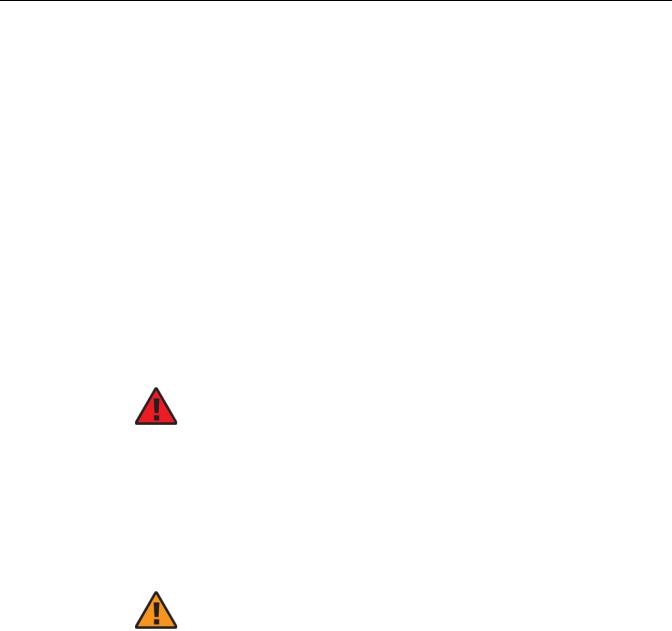
Release 05.08.01a | August 2018 | Edition 01
7368 ISAM ONT G-240W-G Product Guide |
ETSI ONT safety guidelines |
2 ETSI ONT safety guidelines
This chapter provides information about the mandatory regulations that govern the installation and operation of the optical network terminals (ONTs).
2.1Safety instructions
This section describes the safety instructions that are provided in the ONT customer documentation and on the equipment.
2.1.1Safety instruction boxes
The safety instruction boxes are provided in the ONT customer documentation. Observe the instructions to meet safety requirements.
The following is an example of the Danger box. Danger — Possibility of personal injury.
The Danger box indicates that the described activity or situation may pose a threat to personal safety. It calls attention to a situation or procedure which, if not correctly performed or adhered to, may result in death or serious physical harm.
Do not proceed beyond a Danger box until the indicated conditions are fully understood and met.
The following is an example of the Warning box.
Warning 1 — Possibility of equipment damage. Warning 2 — Possibility of data loss.
The Warning box indicates that the described activity or situation may, or will, cause equipment damage, loss of data, or serious performance problems. It identifies a possible equipment-damaging situation or provides essential information to avoid the degradation of system operations or data.
Do not proceed beyond a warning until the indicated conditions are fully understood and met.
Issue: 01 |
3FE-47555-AAAA-TCZZA |
17 |
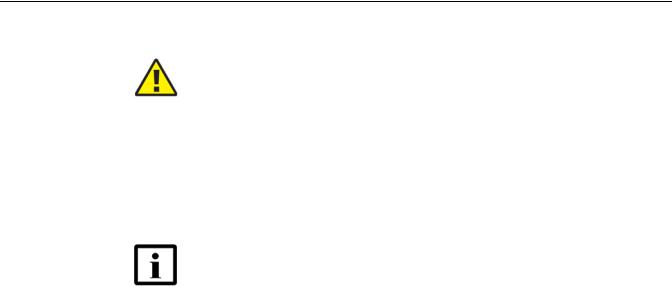
Release 05.08.01a | August 2018 | Edition 01
ETSI ONT safety guidelines |
7368 ISAM ONT G-240W-G Product Guide |
The following is an example of the Caution box.
Caution 1 — Possibility of service interruption.
Caution 2 — Service interruption.
The Caution box indicates that the described activity or situation may, or will, cause service interruption.
Do not proceed beyond a caution until the indicated conditions are fully understood and met.
The following is an example of the Note box.
Note — Information of special interest.
The Note box provides information that assists the personnel working with ONTs. It does not provide safety-related instructions.
2.1.2Safety-related labels
The ONT equipment is labeled with the specific safety instructions and compliance information that is related to a variant of the ONT. Observe the instructions on the safety labels.
Table 1 provides sample safety labels on the ONT equipment.
Table 1 |
Safety labels |
|
|
|
|
Description |
|
Label text |
|
|
|
ESD warning |
|
Caution: This assembly contains an electrostatic sensitive device. |
|
|
|
Laser classification |
Class 1 laser product |
|
|
|
|
PSE marking |
|
These power supplies are Japan PSE certified and compliant with |
|
|
Japan VCCI emissions standards. |
|
|
|
Figure 1 shows the PSE certification.
18 |
3FE-47555-AAAA-TCZZA |
Issue: 01 |

Release 05.08.01a | August 2018 | Edition 01
7368 ISAM ONT G-240W-G Product Guide |
ETSI ONT safety guidelines |
Figure 1 |
PSE certification |
|
|
|
|
|
|
This is a Class B product based on the standard of the Voluntary Control Council for Interference |
|
|
from Information Technology Equipment (VCCI). If this is used near a radio or television receiver in |
|
|
a domestic environment, it may cause radio interference. Install and use the equipment according |
|
Warning |
to the instruction manual. |
|
|
|
|
|
|
19841
2.2Safety standards compliance
This section describes the ONT compliance with the European safety standards.
2.2.1EMC, EMI, and ESD compliance
The ONT equipment complies with the following EMC, EMI, and ESD requirements:
•EN 300-328 v1.9.1 wide band data transmission standards for 2.4GHz bands
•EN 300-386 V1.5.1: Electromagnetic Compatibility and Radio Spectrum Matters (ERM): Telecommunications Network Equipment; Electromagnetic Compatibility (EMC) requirements; Electrostatic Discharge (ESD) requirements
•EN 55022 (2006): Class B, Information Technology Equipment, Radio Disturbance Characteristics, limits and methods of measurement
•EN 55024 (2010): Information Technology Equipment, Immunity Characteristics, limits and methods of measurement
•European Council Directive 2004/108/EC
•EN 300-386 V1.4.1: 2008
•EN 55022:2006 Class B (ONTs)
2.2.2Equipment safety standard compliance
The ONT equipment complies with the requirements of EN 60950-1, Safety of Information Technology Equipment for use in a restricted location (per R-269).
Issue: 01 |
3FE-47555-AAAA-TCZZA |
19 |

Release 05.08.01a | August 2018 | Edition 01
ETSI ONT safety guidelines |
7368 ISAM ONT G-240W-G Product Guide |
2.2.3Environmental standard compliance
The ONT equipment complies with the EN 300 019 European environmental standards.
2.2.4CE RED RF Radiation Exposure Statement
This device complies with CE RED radiation exposure limits set forth for an uncontrolled environment. To comply with CE RED RF exposure compliance requirements, this grant is applicable only for mobile configurations. The antennas used for the transmitter must be installed to provide a separation distance of at least 20 cm from all persons and must not be co-located or operating in conjunction with any other antenna or transmitter.
2.2.5Laser product standard compliance
For most ONTs, the ONT equipment complies with EN 60825-1 and IEC 60825-2 for laser products. If there is an exception to this compliance regulation, you can find this information in the standards compliance section of the unit data sheet in this Product Guide.
2.2.6Resistibility requirements compliance
The ONT equipment complies with the requirements of ITU Recommendation K.21 for resistibility of telecommunication equipment installed in customer premises to over voltage and overcurrents.
2.2.7Acoustic noise emission standard compliance
The ONT equipment complies with EN 300 753 acoustic noise emission limit and test methods.
20 |
3FE-47555-AAAA-TCZZA |
Issue: 01 |

Release 05.08.01a | August 2018 | Edition 01
7368 ISAM ONT G-240W-G Product Guide |
ETSI ONT safety guidelines |
2.3Electrical safety guidelines
This section provides the electrical safety guidelines for the ONT equipment.
Note 1 — The ONTs comply with the U.S. National Electrical Code. However, local electrical authorities have jurisdiction when there are differences between the local and U.S. standards.
Note 2 — The ONTs comply with BS EN 61140.
2.3.1Power supplies
The use of any non-Nokia approved power supplies or power adapters is not supported or endorsed by Nokia. Such use will void any warranty or support contract with Nokia. Such use greatly increases the danger of damage to equipment or property.
2.3.2Cabling
The following are the guidelines regarding cables used for the ONT equipment:
•All cables must be approved by the relevant national electrical code.
•The cables for outdoor installation of ONTs must be suitable for outdoor use.
•POTS wiring run outside the subscriber premises must comply with the requirements of local electrical codes. In some markets, the maximum allowed length of the outside run is 140 feet (43 m). If the outside run is longer, NEC requires primary protection at both the exit and entry points for the wire.
2.3.3Protective earth
Earthing and bonding of the ONTs must comply with the requirements of local electrical codes.
Issue: 01 |
3FE-47555-AAAA-TCZZA |
21 |

Release 05.08.01a | August 2018 | Edition 01
ETSI ONT safety guidelines |
7368 ISAM ONT G-240W-G Product Guide |
2.4ESD safety guidelines
The ONT equipment is sensitive to ESD. Operations personnel must observe the following ESD instructions when they handle the ONT equipment.
Caution — This equipment is ESD sensitive. Proper ESD protections should be used when you enter the TELCO Access portion of the ONT.
During installation and maintenance, service personnel must wear wrist straps to prevent damage caused by ESD.
2.5Laser safety guidelines
Observe the following instructions when you perform installation, operations, and maintenance tasks on the ONT equipment.
Only qualified service personnel who are extremely familiar with laser radiation hazards should install or remove the fiber optic cables and units in this system.
Danger — There may be invisible laser radiation at the fiber optic cable when the cable is removed from the connector. Avoid direct exposure to the laser beam.
Observe the following danger for laser hazard. Eyes can be damaged when they are exposed to a laser beam. Take necessary precautions before you plug in the optical modules.
Danger — Possibility of equipment damage. Risk of eye damage by laser radiation.
2.5.1Laser classification
The ONT is classified as a Class 1 laser product based on its transmit optical output.
2.5.1.1Laser warning labels
The following figures show the labels related to laser product, classification and warning.
22 |
3FE-47555-AAAA-TCZZA |
Issue: 01 |
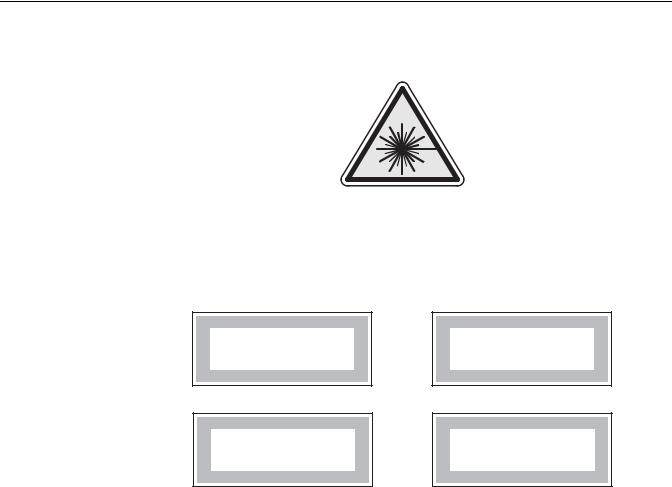
Release 05.08.01a | August 2018 | Edition 01
7368 ISAM ONT G-240W-G Product Guide |
ETSI ONT safety guidelines |
Figure 2 shows a laser product label.
Figure 2 Laser product label
18455
Figure 3 shows a laser classification label. Laser classification labels may be provided in other languages.
Figure 3 Laser classification label
CLASS 1 LASER PRODUCT
' CLASE 1 DEL LASER
' PRODUCTO LASER CLASE 1
LASER CLASSE 1
18992
Figure 4 shows a laser warning label and an explanatory label for laser products. Labels and warning may be provided in other languages. The explanatory label provides the following information:
•a warning that calls attention to the invisible laser radiation
•an instruction against staring into the beam or viewing directly with optical instruments
•wavelength
•normal output power
•maximum output power
Issue: 01 |
3FE-47555-AAAA-TCZZA |
23 |
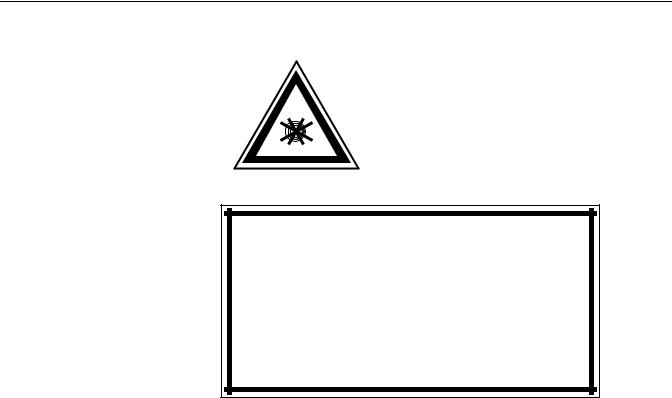
Release 05.08.01a | August 2018 | Edition 01
ETSI ONT safety guidelines |
7368 ISAM ONT G-240W-G Product Guide |
Figure 4 Laser warning labels
|
|
|
|
|
|
|
|
|
|
|
|
|
|
|
|
|
|
|
|
|
|
|
|
INVISIBLE LASER RADIATION |
|
|
|
|
|
|
|
|
DO NOT STARE INTO BEAM |
|
|
|
|
|
|
|
|
OR VIEW DIRECTLY WITH |
|
|
|
|
|
|
|
|
OPTICAL INSTRUMENTS |
|
|
|
|
|
|
|||||
|
|
|
|
|
|
Wavelength(s): xxxx nm |
|
|
|
|
|
|
|
|
Normal output power: xx m W |
|
|
|
|
|
|
|
|
Max output power: yyy m W |
|
|
|
|
|
|
|||||
|
|
|
|
|
|
|
|
|
|
|
|
|
|
|
|
|
|
Laser Warning Label |
|
|
Laser Warning Label |
|||||
CLASS 1 LASER PRODUCT
RAYONNEMENT LASER CLASSE 1
RAYONNEMENT LASER INVISIBLE ' EVITER TOUTE EXPOSITION AU FAISCEAU
NE PAS DEMONTER. FAIRE APPEL A UN PERSONNELL QUALIFIE
CLASE 1 DEL LASER
RADIACION DE LASER INVISIBLE. EVITAR CUALOUIER EXPOSICION AL
RAYO LASER. NO DESMONTAR. LLAMAR A PERSONAL AUTORIZADO
INVISIBLE LASER RADIATION PRESENT AT FIBER OPTIC CABLE
WHEN NOT CONNECTED. AVOID DIRECT EXPOSURE TO BEAM.
Laser Warning Label
18993
2.5.2Laser classification
The ONT is classified as a Class 1 laser product based on its transmit optical output.
For Class 1 laser products, lasers are safe under reasonably foreseeable conditions of operation, including the use of optical instruments for intrabeam viewing.
Figure 5 shows a sample laser product safety label on the ONT equipment.
24 |
3FE-47555-AAAA-TCZZA |
Issue: 01 |
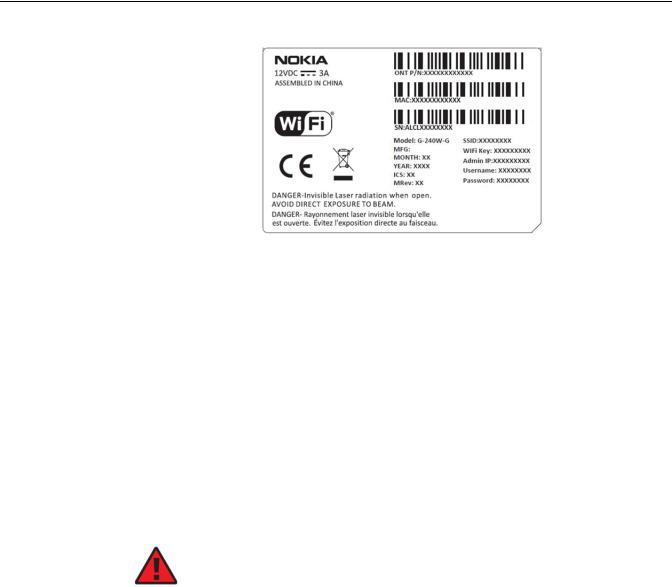
Release 05.08.01a | August 2018 | Edition 01
7368 ISAM ONT G-240W-G Product Guide |
ETSI ONT safety guidelines |
Figure 5 Sample laser product safety label on the ONT equipment
2.5.3Transmit optical output
The maximum transmit optical output of an ONT is +5 dBm.
2.5.4Normal laser operation
In normal operation, fiber cable laser radiation is always off until it receives signal from the line terminal card.
Eyes can be damaged when they exposed to a laser beam. Operating personnel must observe the instructions on the laser explanatory label before plugging in the optical module.
Danger — Risk of eye damage by laser radiation.
2.5.5Location class
Use cable supports and guides to protect the receptacles from strain.
2.6Environmental requirements
See the ONT technical specification documentation for more information about temperature ranges.
Issue: 01 |
3FE-47555-AAAA-TCZZA |
25 |

Release 05.08.01a | August 2018 | Edition 01
ETSI ONT safety guidelines |
7368 ISAM ONT G-240W-G Product Guide |
During operation in the supported temperature range, condensation inside the ONT caused by humidity is not an issue. To avoid condensation caused by rapid changes in temperature and humidity, Nokia recommends:
•The door of the ONT not be opened until temperature inside and outside the enclosure has stabilized.
•If the door of the ONT must be opened after a rapid change in temperature or humidity, use a dry cloth to wipe down the metal interior to prevent the risk of condensation.
•When high humidity is present, installation of a cover or tent over the ONT helps prevent condensation when the door is opened.
26 |
3FE-47555-AAAA-TCZZA |
Issue: 01 |

Release 05.08.01a | August 2018 | Edition 01
7368 ISAM ONT G-240W-G Product Guide |
ETSI environmental and CRoHS guidelines |
3ETSI environmental and CRoHS guidelines
This chapter provides information about the ETSI environmental China Restriction of Hazardous Substances (CRoHS) regulations that govern the installation and operation of the optical line termination (OLT) and optical network termination (ONT) systems. This chapter also includes environmental operation parameters of general interest.
3.1Environmental labels
This section describes the environmental instructions that are provided with the customer documentation, equipment, and location where the equipment resides.
3.1.1Overview
CRoHS is applicable to Electronic Information Products (EIP) manufactured or sold and imported in the territory of the mainland of the People’s Republic of China. EIP refers to products and their accessories manufactured by using electronic information technology, including electronic communications products and such subcomponents as batteries and cables.
3.1.2Environmental related labels
Environmental labels are located on appropriate equipment. The following are sample labels.
3.1.2.1Products below Maximum Concentration Value (MCV) label
Figure 6 shows the label that indicates a product is below the maximum concentration value, as defined by standard SJ/T11363-2006 (Requirements for Concentration Limits for Certain Hazardous Substances in Electronic Information Products). Products with this label are recyclable. The label may be found in this documentation or on the product.
Issue: 01 |
3FE-47555-AAAA-TCZZA |
27 |

Release 05.08.01a | August 2018 | Edition 01
ETSI environmental and CRoHS guidelines |
7368 ISAM ONT G-240W-G Product Guide |
Figure 6 Products below MCV value label
18986
3.1.2.2Products containing hazardous substances above Maximum Concentration Value (MCV) label
Figure 7 shows the label that indicates a product is above the maximum concentration value, as defined by standard SJ/T11363-2006 (Requirements for Concentration Limits for Certain Hazardous Substances in Electronic Information Products). The number contained inside the label indicates the Environment-Friendly User Period (EFUP) value. The label may be found in this documentation or on the product.
Figure 7 Products above MCV value label
28 |
3FE-47555-AAAA-TCZZA |
Issue: 01 |

Release 05.08.01a | August 2018 | Edition 01
7368 ISAM ONT G-240W-G Product Guide |
ETSI environmental and CRoHS guidelines |
Together with major international telecommunications equipment companies, Nokia has determined it is appropriate to use an EFUP of 50 years for network infrastructure equipment and an EFUP of 20 years for handsets and accessories. These values are based on manufacturers' extensive practical experience of the design, manufacturing, maintenance, usage conditions, operating environments, and physical condition of infrastructure and handsets after years of service. The values reflect minimum values and refer to products operated according to the intended use conditions. See “Hazardous Substances Table (HST)” for more information.
3.2Hazardous Substances Table (HST)
This section describes the compliance of the OLT and ONT equipment to the CRoHS standard when the product and subassemblies contain hazardous substances beyond the MCV value. This information is found in this user documentation where part numbers for the product and subassemblies are listed. It may be referenced in other OLT and ONT documentation.
In accordance with the People’s Republic of China Electronic Industry Standard Marking for the Control of Pollution Caused by Electronic Information Products (SJ/T11364-2006), customers may access the Nokia Hazardous Substance Table, in Chinese, from the following location:
http://www.nokia-sbell.com/wwwroot/images/upload/private/1/media/ChinaRoHS.p df
3.3Other environmental requirements
Observe the following environmental requirements when handling the P-OLT or ONT equipment.
3.3.1ONT environmental requirements
See the ONT technical specification documentation for more information about temperature ranges.
3.3.2Storage
According to ETS 300-019-1-1 - Class 1.1, storage of OLT equipment must be in Class 1.1, weather-protected, temperature-controlled locations.
Issue: 01 |
3FE-47555-AAAA-TCZZA |
29 |

Release 05.08.01a | August 2018 | Edition 01
ETSI environmental and CRoHS guidelines |
7368 ISAM ONT G-240W-G Product Guide |
3.3.3Transportation
According to EN 300-019-1-2 - Class 2.3, transportation of the OLT equipment must be in packed, public transportation with no rain on packing allowed.
3.3.4Stationary use
According to EN 300-019-1-3 - Class 3.1/3.2/3.E, stationary use of OLT equipment must be in a temperature-controlled location, with no rain allowed, and with no condensation allowed.
3.3.5Thermal limitations
When the OLT is installed in the CO or CEV, install air filters on the P-OLT. The thermal limitations for OLT operation in a CO or CEV are:
•operating temperature: 5°C to 40°C (41°F to 104°F)
•short-term temperature: –5°C to 50°C (23°F to 122°F)
•operating relative humidity: 5% to 85%
•short-term relative humidity: 5% to 95%, but not to exceed 0.024 kg of water/kg
3.3.6Material content compliance
European Union (EU) Directive 2002/95/EC, “Restriction of the use of certain Hazardous Substances” (RoHS), restricts the use of lead, mercury, cadmium, hexavalent chromium, and certain flame retardants in electrical and electronic equipment. This Directive applies to electrical and electronic products placed on the EU market after 1 July 2006, with various exemptions, including an exemption for lead solder in network infrastructure equipment. Nokia products shipped to the EU after 1 July 2006 comply with the EU RoHS Directive.
Nokia has implemented a material/substance content management process. The process is described in: Nokia process for ensuring RoHS Compliance (1AA002660031ASZZA). This ensures compliance with the European Union Directive 2011/65/EU on the Restriction of the Use of Certain Hazardous Substances in Electrical and Electronic Equipment (RoHS2). With the process equipment is assessed in accordance with the Harmonised Standard EN50581:2012 (CENELEC) on Technical documentation for the assessment of electrical and electronic products with respect to the restriction of hazardous substances.
30 |
3FE-47555-AAAA-TCZZA |
Issue: 01 |
